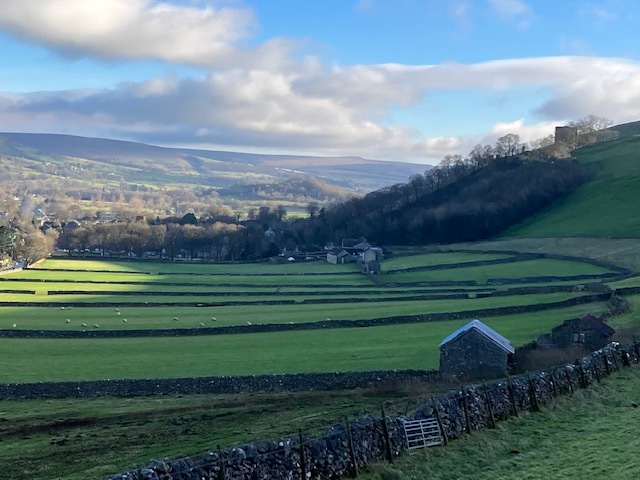Derbyshire council’s future plans for mineral extraction include a possible reduction in quarrying in the beautiful and scenic Peak District National Park despite objections from some quarry operators.
The county council’s Cabinet approved the submission of the Derbyshire and Derby Joint Minerals Local Plan – which has been prepared with Derby City Council – for the Secretary of State for Housing, Communities and Local Government, during a meeting on September 18.
Cllr Carolyn Renwick, Cabinet member for Infrastructure and Environment, told the meeting the minerals industry employs thousands of people in Derbyshire but it is still important to maintain areas in a sustainable way.
Concerning the plan, she added: “It is a long process but we have worked really, really hard to get representations from people.”
One of the plan’s key issues is reducing quarrying in the Peak District National Park, which has been met with objections from a number of quarry operators, and another includes safeguarding coal resource land, which Chesterfield Borough Council believes could prevent future growth in the borough.
Peak District National Park Authority fully supports the plan’s policy approach for a gradual reduction of quarrying in the National Park, according to the county council, which sets out an approach between the county and Derby City Councils and the Peak authority to implement a gradual reduction of quarrying in the National Park.
This would involve a 10per cent reduction in the park authority’s provision for aggregate crushed rock which would be a compensated with an expected 10per cent increase in Derbyshire County Council’s overall provision of the same rock.
However, a number of quarry operators have objected to this approach, including the Minerals Products Association, Breedon and Tarmac on grounds that the policy is not supported by the National Planning Policy Framework.
But the council’s officers argued the policy approach accords with the NPPF which states, as far as is practical, provision should be made for the maintenance of landbanks of non-energy minerals from outside National Parks.
This is aimed at conserving and enhancing landscape and scenic beauty in National Parks, according to the county council, and that protection afforded to National Parks is set out in the Environment Act and the National Parks and Access to the Countryside Act.
However, the county council explained this approach does not mean an end to quarrying in the Peak District with the approach only relating to aggregate crushed rock and the park authority’s core strategy still sets out that proposals for new or extended quarries for crushed rock will still be considered in exceptional circumstances.
The council stated that consequently it has been proposed that this issue is addressed through a Statement of Common Ground between the County and City Councils and the Peak authority confirming each of the authorities agree with the policy.
Chesterfield Borough Council has also objected to the safeguarding of coal resources and to the Proposals Map for Mineral Safeguarding Areas which includes the borough but the county council stated that a safeguarding area does not necessarily prevent other developments but it does allow this aspect to be considered in any planning process.
The borough council argued there is no longer any domestic market for coal, and that such an approach would impact adversely on the delivery of growth particularly within built up areas and allocated sites within the borough council’s Local Plan.
Derbyshire County Council acknowledged the borough council’s objections and even though it feels it is necessary to define safeguarding areas it recognised this conflicts with the lack of any significant UK market for coal and with need to address climate change and meet net zero targets by 2050.
So the county council has proposed this issue will also be addressed through a Statement of Common Ground with the borough council setting out the county and city councils’ acceptance of the borough’s ’s position which will be addressed through modifications.
The council states its overall plan sets out priorities for delivering sustainable mineral developments within a framework of strategic policies and non-strategic, development management policies aimed at avoiding and minimising and mitigating the adverse impacts of mineral development.
A public consultation was held on the plan which included drop-in events which resulted in 412 representations being received from 50 organisations or individuals.
Other key issues considered included climate change, the supply of aggregates, sand, gravel, crushed rock, building stone, limestone, fossil fuels and coal, and site allocations for sand and gravel.
South Derbyshire District Council objected to the allocation of sand and gravel sites in the Trent and Dove Valleys on the grounds that the plan is allocating more sites than are needed.
This district council also argued there has been no investigation as to whether the working of minerals on a number of specific sand and gravel allocation sites could lead to an increase in flood risk in the Lower Dove Valley.
But the council has stated planning requirements for the sand and gravel sites includes detailed consideration of flood issues with the potential for operators to provide improvements against flood risk.
It also argued that it is important to continue the proposed level of sand and gravel provision and allocations to ensure the continued steady and adequate supply of sand and gravel required by national policy.
South Derbyshire District Council also expressed concerns about site allocations at Foston and Sudbury but the county council feels these can be addressed with mitigation measures when planning applications are considered.
However, the county council has once again proposed to address these concerns through a Statement of of Common Ground with South Derbyshire District Council.
Derbyshire County Council has also suggested mitigation strategies to help reduce the impact on heritage assets should be part of the plan after Heritage England had raised objections regarding the impact of minerals development on important heritage assets.
County council officers have drafted a Schedule of Major and Minor Modifications which they consider will address concerns to ensure the overall plan is sound and compliant with national planning legislation and policy and this will be submitted at a later stage.
The county council’s Cabinet’s decision to approve the submission of the plan to the Secretary of State will need to be agreed at a Full Council meeting, on October 9, and the plan is expected to be committed to the Secretary of State in November with a public examination due between April and June, 2025, with the possible adoption expected by December, 2025.
Derbyshire County Council and Derby City Council have been working together to prepare the new joint, minerals local plan for the period up to 2038.
County council Leader, Cllr Barry Lewis, said: “It’s a significant industry for Derbyshire. It is worth mentioning that there has been an amazing job done because it is a nationally important strategy in Derbyshire.”





